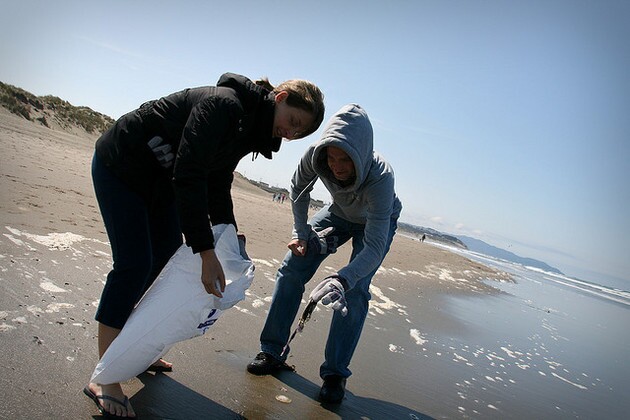You Can Help Clean Up Ocean Plastic on Coastal Cleanup Day

Are you worried about the floating conglomeration of plastic trash in the Pacific Ocean?Disappointed that high-concept tech solutions to the ocean plastic problem probably won't work? Are you looking for something you can do to help keep plastic out of the ocean for real?
Or are you maybe just looking for an excuse to get outside this weekend?
Either way, the annual California Coastal Cleanup, scheduled for Saturday, September 19, offers a chance to join your fellow Californians to take direct action to reduce the amount of plastic and other trash going into the Pacific Ocean.
The California Coastal Cleanup is part of the Ocean Conservancy's International Coastal Cleanup, which the Guinness Book of World Records calls the world's largest coordinated, single-day volunteer effort. In 2014 in California alone, 66,292 volunteers collected more than a million pounds of trash and almost 99,000 pounds of recyclables from California beaches, coastlines, and inland streams. Most of that total consisted of single-use disposable plastic items.
Despite the recent popularity of schemes forskimming plastic off the surface of the ocean, internet oceanographers and marine engineers suggest that beach cleanups like the California Coastal Cleanup are actually far more effective at removing ocean plastics. A significant amount of plastic floating in ocean gyre patches like the so-called "great Pacific Garbage Patch" is ejected from the gyre each cycle, after which it can wash ashore temporarily.
When people come by and pick that trash off the beach and dispose of it properly, it stays out of the ocean. And that makes the California Coastal Cleanup a remarkably efficient way to help clean up at least a little bit of the burden of trash borne by our ocean, and the wildlife that lives in it.
The 2015 California Coastal Cleanup includes more than 850 sites across California. You can find the cleanup sites closest to you on the Coastal Cleanup website. Not near the ocean? That might not matter: the state's interior will host cleanup events in places far from the Pacific, including the Sierra Nevada and Imperial County.
Participants are being asked to bring reusable buckets, and bags for collecting trash, as well as reusable work gloves, though organizers will have gear available for people who just show up.
The coast cleanup is just a partial remedy for the ocean plastic problem. About 80 percent of plastic in the ocean comes from land, from our landfills and wind-blown trash improperly tossed into streets, streams, and elsewhere. In the long run, solving the ocean plastic problem will mean we need to reduce the amount of plastic we dump into our environment in the first place. California's made some important strides in that regard, what with plastic bag bans like those recently enacted in the state.
One of the biggest plastic problems in the ocean comes from so-called "microbeads," the tiny plastic pellets discussed in an episode of SoCal Connected earlier this year. Early in September the California Legislature approved a bill -- Assembly Bill 888 -- that will ban microbeads in cosmetic products in the state, and Governor Jerry Brown is expected to sign it. (The bill was voted down in the State Senate on September 3, but passed a second vote after a provision requiring natural microbead alternatives was struck from the bill's language.)
So reducing the amount of plastic we discard in our daily lives is the long-term answer to the issue of ocean plastics. But there's no better way to remind yourself of the severity of the problem than to get out on the beach Saturday and pick some of that ocean plastic up for proper disposal.
The California Coastal Cleanup is spearheaded by the California Coastal Commission, with many cooperating partner organizations.


